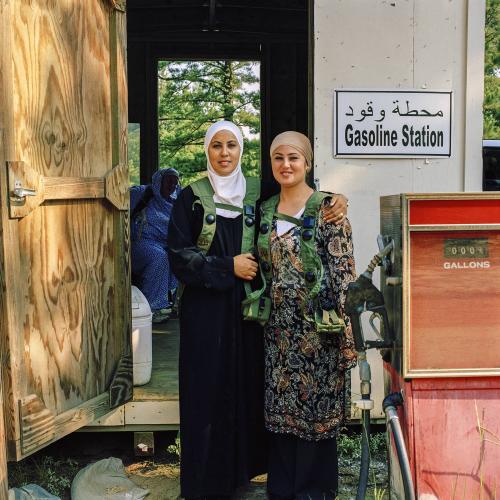

Featured Audio
Inside Military ‘Training Villages’
Chris Sims talked about his work in the season premiere of Sanford's Policy 360 podcast.
Most Americans don’t know that there are several elaborate pretend Iraqi and Afghan villages on U.S. soil. Imagine a house, designed to look like a house in Baghdad, with similar architecture. A variety of such homes, shops and small businesses comprise a makeshift village. There are people inside these villages.

Many of the people were born in the Middle East and immigrated to the U.S., and now play roles in the communities- a pretend version of themselves, in pretend Middle Eastern villages, in the very real forests and deserts of the U.S.
These pretend villages cover thousands of acres on the training grounds of U.S. Army bases.
One of Sanford’s newest faculty members, Christopher Sims, first heard about the villages when he was at Fort Bragg, N.C. for a photographic project. An acclaimed photographer, Sims is currently the Undergraduate Education Director at Duke’s Center for Documentary Studies. He has just been named an associate professor of the practice at the Sanford School of Public Policy. He was intrigued by these pretend villages and eventually was able to gain access. He has visited villages on three bases thus far: Fort Bragg, Fort Irwin in southern California and Fort Polk in Louisiana.
Sims is not just a bystander. He has spent time living in the villages, even playing roles himself, like war photographer for the fictitious “International News Network.” It’s a little like being backstage in the war on terrorism, he says.
Storylines include “insurgents planting a bomb in a Red Crescent ambulance; American soldiers negotiating with a reluctant mayor; a suicide bomber detonating herself outside of a mosque; and villagers erupting in an anti-American riot.”
Featured Image
From the book The Pretend Villages.
Earlier in his career, Sims was a photo archivist at the United States Holocaust Memorial Museum. He says he was not drawn to the battlefield images, but to quieter ones. The battle images are the ones many people turn away from, he remembers.
“I began to think, ‘What are ways we can help bridge the military-civilian divide?”
Sims says that the pretend village’s population often includes military veterans – even amputees injured in real-life previous wars who play the role of wounded villagers while on set. The actors do what real villagers would do. In fact, it feels almost like a real village. Villagers plant vegetables, cook, gossip, play cards – all while waiting for inevitable interaction with the U.S. military. Chris Sims says the situation feels almost like a mix of the utopian and dystopian. One couple met, fell in love, and got married -- both in the village and in real life.
It’s all a bit “strange and mysterious,” Sims notes, adding that the goal of his photography project “Theater of War: The Pretend Villages of Iraq and Afghanistan” is not to explain how military training is done, “but to instead to let us see something that we think we understand, and reveal it in a new way.”

In America, we have had constant, “forever wars” in the Middle East. Sims says he hopes his photos will help the rest of us look at the situation anew and question our policy goals. “What are we doing? Why are we doing this? Is it working or not working?”
Many of his photos from the project are collected in his new book, The Pretend Villages: Inside the U.S. Military Training Grounds, published by Kehrer Verlag. A large-scale exhibition of this work will be on display October 23, 2021 to February 27, 2022 in Duke’s Rubenstein Library Photography Gallery, and will include a text introduction by Sanford’s Abdullah Antepli.
Photography, Sims argues, invites people into the conversation. He believes visual research and documentary work can be accessible mediums that show how ordinary individuals experience, apply, and adapt to policy decisions about resources, strategy, values, and priorities made by officials and institutions often far removed from their lives.
Sims has had a connection with the Sanford School before he was invited to be part of the core faculty. Last spring, he taught a master’s-level course that explored ethics and equity in media in which students discussed how stories are told, and who gets to tell them.
Sims has an undergraduate degree in history from Duke, a master’s degree in visual communication from the University of North Carolina at Chapel Hill, and an M.F.A. in studio art from the Maryland Institute College of Art.
